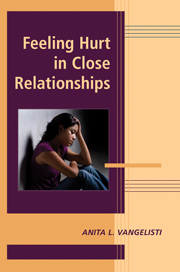Book contents
- Frontmatter
- Contents
- List of Contributors
- Foreword
- PART I INTRODUCTION
- PART II CONCEPTUALIZING HURT
- PART III HURTFUL ACTS
- PART IV HURT IN RELATIONAL CONTEXTS
- PART V HURT IN APPLIED CONTEXTS
- 17 The Physiology of Feeling Hurt
- 18 Hurt and Psychological Health in Close Relationships
- 19 Technology and Hurt in Close Relationships
- 20 Hurt Feelings and the Workplace
- 21 Cultural Influences on the Causes and Experience of Hurt Feelings
- 22 Hurt Feelings: The Last Taboo for Researchers and Clinicians?
- Author Index
- Subject Index
- References
17 - The Physiology of Feeling Hurt
from PART V - HURT IN APPLIED CONTEXTS
Published online by Cambridge University Press: 04 August 2010
- Frontmatter
- Contents
- List of Contributors
- Foreword
- PART I INTRODUCTION
- PART II CONCEPTUALIZING HURT
- PART III HURTFUL ACTS
- PART IV HURT IN RELATIONAL CONTEXTS
- PART V HURT IN APPLIED CONTEXTS
- 17 The Physiology of Feeling Hurt
- 18 Hurt and Psychological Health in Close Relationships
- 19 Technology and Hurt in Close Relationships
- 20 Hurt Feelings and the Workplace
- 21 Cultural Influences on the Causes and Experience of Hurt Feelings
- 22 Hurt Feelings: The Last Taboo for Researchers and Clinicians?
- Author Index
- Subject Index
- References
Summary
For better or worse, the interdependency that defines close relationships grants one partner the ability to critically affect the other partner's outcomes. Perhaps nowhere are these double-edged effects better documented than in research on the link between close relationships and physical health or health-relevant physiological parameters; whereas satisfying intimate relationships procure a range of beneficial outcomes (e.g., Coan, Schaefer, & Davidson, 2006), they also have the ability to produce great harm (Robles & Kiecolt-Glaser, 2003). Without question, from the nasty remark to the unexpected breakup, intimate partners hold the power to hurt the feelings and subsequently the health outcomes of one another like few other individuals.
Interestingly, despite the prevalence of hurtful acts, writing a chapter on the physiological consequences of hurt feelings in close relationships presents unique challenges, given the surprising lack of empirical research that directly examines the link between feeling hurt and bodily responses. Ideally, we would review studies that deliberately incorporated stimuli-response designs such that physiological outcomes were assessed subsequent to hurtful acts (e.g., hormone responses when one partner belittles the other); however, few studies have been conducted with these explicit goals in mind. Fortunately, several lines of related research provide critical insight into why and how hurtful acts may “get under our skin.” Specifically this chapter includes work assessing consequences of interpersonal dynamics and contexts that are conceptually similar to those producing hurt feelings that have been empirically linked to physiological parameters.
- Type
- Chapter
- Information
- Feeling Hurt in Close Relationships , pp. 359 - 375Publisher: Cambridge University PressPrint publication year: 2009
References
- 5
- Cited by



